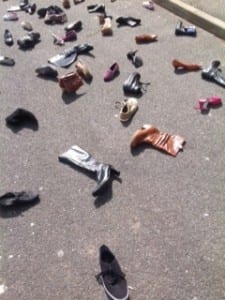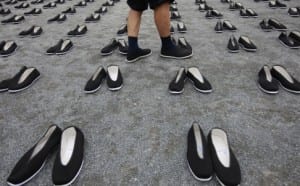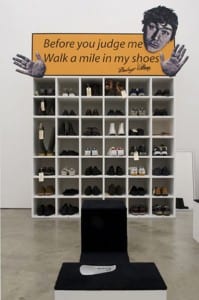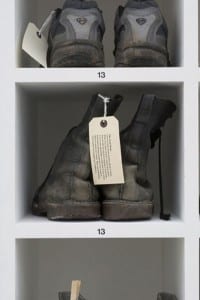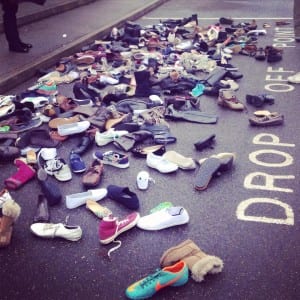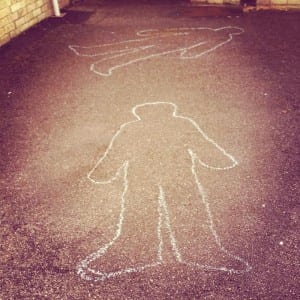Framing Statement
The Grandstand project, which is what we worked on since last January. ‘A body without a home’ was our performance piece that we mainly inspired from the idea of our module tutor mentioned and the idea is focused on to the Grandstand as a mortuary and we overlapped with the fact of Grandstand is a venue of Mosque services. The performance was involve with a pile of shoes and it is an images of ‘Holocaust’ for mortuary side and Mosques services are not allowing to pray with shoes on and this is why we chosen to put those different theme together. On the other hand, we tried to not create severe point because talk about something religion and death is has got some risks of to make feeling of shock and anxious to other people. For the actually performance piece, we used the ‘drop off point’ in first part and after wards we moved down to courtyards which located at behind the back entrance of Grandstand which is close to golf field and there was a fence in between Grandstand building and the field. The space of courtyard had got a big and long empty space to we were able to lie down, stretches ourselves and it was enough wideness to put the amount of shoes.
The duration of this performance was throughout three hours and performances are included following elements. The images of shoes in outside of the Grandstand’s ‘Drop off point’ area were for make a sense of the fact of majority of people’s existence and mosque prayers. In courtyard the shoes represent that people who passed away in both present and past especially in war time. The monologues we spoken were for to create an atmosphere of silence, the sense of different time period of the Grandstand. Also this is for throughout some questions for audiences about what can you see in your personal view. When the shoes are carried by pairs and individually, this was for to create the sense of dead body which was able to find out and did not find out. The visual images of missing were difficult to describe without a specific bodies but the shoes are normally in pairs and if it has missed by any chance it is also telling us to the idea of something must happened to the owner.
For the side of influenced, I personally found an interesting case which still connecting to the idea of in between shoes and war time such as from the article of South China Morning Post reported on 26, February 2014. The article is about the wartime compensation issues of Chinese forced labourers who worked in Japan and passed away during the World War II and there was a 6,830 pairs of cloth shoes forced labourers in Chinese park. According to this fact, war is a general historic event for most of people and almost every one is taking some damages and pain from it. A member of the class-action suit Zhang Shan said; “As there is no way to get justice in Japan, the Chinese victims of forced labour and their families are determined to sue in China the Japanese companies which did them harm,” (South-China Morning Post, 2014)
(South-China Morning Post, [Image]avaliable at http://www.scmp.com/news/china/article/1435587/chinese-workers-forced-wartime-labour-sue-japan-firms-damages [accessed on 3 April, 2014])
Development process
As an idea of this performance piece in the beginning, we originally thinking about to the idea of ‘time archaeologist of the war time’ which means we as an archaeologists of create some symbols of war time by using of materials which is Grandstand has got (chairs, tables etc) already. For example, to create a horse, tank, battle plaine and trench. This is because the fact of we found when we visited the Lincoln Archives and there was an evidence of the Grandstad was involved in world war as a factory of battle plaine. In addition, I researched about the war horse that also involved during the war time and I looked at the side of emotions of war horses rather than how we used them during the war. From the previous blog post that I posted on 12 of March, I mentioned the one of a book which written about war horses and author General Jack Seely illustrated that:
‘People who do not understand the realities of warfare think that horses are not required on modern battlefields. They think that all battles will be conducted by mechanical means. So they will be for the first few days, then it will be the horse. Truly the horse might cry out more loudly than any other creature, “Give peace in our time, O Lord.”‘
(Selly, 2011, p114)
and I thought this could be a good element for our piece because live art is the piece which create an impact for audience but the only problem is if it is not good enough to present, people will not understand anything from it. Throughout this development process, a module tutor of site-specific performance gave some ideas of ‘shoes’ and ‘mortuary’ which is we found more interesting therefore we changed the whole structures of the performance. Also the idea was very powerful and thoughtful rather than our original idea and that is another reason of why we changed our whole idea.
In the inside of meaning of shoes in our piece (and view points in a different way), shoes are represent a death of the owner in a war time and numbers of shoes are simply presents how many could have involved to the war. On the other hand, pair shoes presented the people who found out after the war but individual shoes are for someone who had not has been found since after the war. In addition, the pile of shoes as a visual sense it presents a scene of when people come to a mosques services of Grandstand. In a mosque services, people will take off their shoes to enter the venue for pray and might be there were a similarities as a ‘pile of shoes’ for both circumstances. However, it was too dangerous to connect each other because both of them are something severe and some people would not like to hear about these. In addition, shoes are material that really hard to vanish from our life and it also can be meaning of the shoes can present human being. By this I mean, shoes tells about us the life background of the person with evidences of how long has been used or the reasons for any damages that we could find on it but basically shoes are ‘signs of sensuousness, comfort, luxury and pleasure.’ (Rozovsky, 1943)
For development process of actual piece, we consider to use the space of ‘drop off point’ which located at front of Grandstand as simple meaning of the place as for drop something. After that, we decided to carry out all shoes to the courtyard of Grandstand which is still outside but much more limited space but it also create a different atmosphere rather than open space. On the ground of the courtyard, we drown around my body by using of a chalk which is present the dead body.
For this scene, we wrote some monologues that something about mentions mortuary, dead body and mosque as a grammatical sense. It was from poem, academic report and definition. For example my monologue was from the definition of mosque pray and BBC religious described it most:
‘Outside every mosque, or just inside the entrance, is a place where worshippers can remove and leave their shoes. There is also a place where they can carry out the ritual washing required before prayer.
The main hall of a mosque is a bare room largely devoid of furniture. There are no pictures or statues. Muslims believe these are blasphemous, since there can be no image of Allah, who is wholly spirit.
Everyone sits on the floor and everywhere in the mosque is equal in status.’
(BBC Religious, 2009, Online)
And my actual monologue was a:
‘Here, the Grandstand, is also open for local mosque services. The majority of people come here everyday and some people come to a big assembly on Friday called ‘Jammat’. They would leave their shoes outside similar to that which you see today in front of you.
During the service, everyone is the same status except in gender but no matter who you are, where you come from or how old you are. We are all going to the same place; cradle to the grave.
The shoes you see in front of you today could belong to living people, but if you go back over 70 years ago these shoes represent the dead. The space you are in, look around, take it in because this could have been where dead bodies lay, bodies without homes. These shoes could have been removed to pray, but also remove from the dead. Which do you see; the past, or the present?’
For additional performance piece that I inspired from, I looked at the piece called Walk a Mile in My shoes by Bedwyr Williams. The piece is about the shoes which Bedwyr Williams bought from second hand shop and he recommends to audience to have some walk with these shoes. All shoes have got a tag on it with some notes about the shoes and some of there are modern, gender mixed and ruined. The very concrete ideas of this piece, the report of Saatchi Gallery stated that
‘Walk A Mile in My Shoes celebrates diversity, inclusion, and community; through the simple practicalities of footwear, Williams extols the values of tolerance and individual difference’ (Saatchi Gallery, 2006).
In my personal view this piece is present the importance of owners’ existence and how shoes describe our history of our life. However, the Saatchi Gallery also reported that ‘The importance that each pair of shoes was purchased second hand underlies the key themes of Williams’s piece’ (Saatchi Gallery, 2006) thus this article is also mentioned that the relationships in between us and other people are also important.
(Bedwyr Williams, Walk A Mile in My Shoes, [Images]avaliable at https://www.saatchigallery.com/artists/bedwyr_williams.htm?section_name=shape_of_things2 [accessed on 29 April, 2014])
For tiny bit of we developed during our piece, we were thinking of to perform just in courtyard but I looked at following article which director of Forced Entertainment Theatre Company, Tim Etchells stated that:
‘The old dialectical separations between inside and outside, fiction and reality, self and other, audience and performer, were here exploited and blurred, leaving the strange sense that the city and oneself were now almost the same thing, a shifting network of narratives, places, touches, voices, lost puns, myths and intimacies’
(Etchells as quoted in Nick Kaye, 2003)
After I looked at this article, I recognised that the movement of us can explore the atmosphere of our piece and even this is able to guide the audience to the different scenes. It is true to say that, when we feel something there is some element around us: When, Where, Who (either with), What and as a visual sense the place actually we were in is very essential to memorise and people to recognise like flashback but it is difficult if it has got a big time gaps. The other part of we developed is the very last scene such as to carry out all shoes in pairs rather than transfer individually and this could made a sense of the number of people who found and have not found at all. However, if we do an exactly same movement as we done in first part, it is just take a while to do and will not make any sense at all (because initially we coming back from zero point) and it means also we distract the impact of that we could make in first part an second part. In the first part, we carry out shoes individually and in last part we changed to carry out shoe with pairs which means we as a finder of dead body and we place them to ‘drop off point’ again. However, in the last part all shoes are organised and it makes more sense to proper image of people who came to mosque service. In addition, in a fragmental way of we changed our piece we managed to finish off with a silence which is to present the sense of one minutes silence at the funeral. This kind of atmosphere is have been already presented during the piece but if we put on purpose, that is a more specific image to end of and the image also reminds that the entire cycle is never end (or the things we are always doing).
Performance Evaluation
For our actual performance, the bodies without home, we were able to engage some audience members throughout the whole piece. The first an hour was a bit of luck because of the beginning of the performance visitors (audience) were not alive yet but our piece takes nearly all 3 hours to complete and I think there was much more opportunity to encourage the audience some point. The audience reaction I could see clearly was when we lay down to the floor of courtyard with pile of shoes around us, I could hear some one was talking ‘this is very good’ and I could also hear shutter sound of cameras. In addition, during the first part which is we carried out all shoes from ‘Drop off point’ that located at front of Grandstand, some people were following us behind the back and it was great circumstances that audience was watching our piece via us but also it could be a guiding of direction to the performance venue for them. I personally believe that our performance could become an influence of work with Grandstand for our (or my personal) further performance in the future. By this I mean this time, we focused on to dead people as a historic context and mosque as a present context but if we slightly changed the focus point such as the people who lived during the war time like soldiers, nurses or people who has have been waiting the return of their important person etc.
For analysis of our final performance, the main point that we have to mention is we could collect enough shoes to perform. If this is not enough the whole impact of images very small. Also I think we were able to work out the time very well. This is because in first part of the performance we decided to carry out all shoes by first an hour but we recognised it took a long while to do it during the actual performance. According to this problem, we tried to change the numbers of shoe we carry out each time such as the first 20 minute we carried a shoe individually (one by one and when a person came back to the drop off point, next person get start to carry out) then after that we made the pace more quicker like as soon as the previous person could see the person comes back to the person get start to carry out even the previous person has not return to original position. The numbers of shoes we actually we carried out is also has changed to random 2 shoes to 3 but we were able to carry out all shoes during the first an hour. The second point that really worked well is again, the visual impact of when we lay down at the courtyard with a lot of shoes around us. This was also completely luck of the amount of shoes we could collect but we could encourage more audience members rather than first part. If we could improve this performance piece, I think we have to make sure everything is have to be sort out from ages before. This is because we took so much time to collect the shoes and the actual movement (to require some shoes donation) that we could get start to make was only 3-4days before of performance date and of course we have to think about time management more specifically. Also if we could change this piece something new, I would like to work on with idea of foot prints of shoes and someone who organising missing peoples’ list.
The whole idea and theory of Site-specific performance was an essence of work with the venue even if the place is non-traditional in a modern style. Site-specific performance was all about how you feel about the place and how you look at the sense, atmosphere and materials which belong to the place from different angle. For the case of Grandstand, even the venue is non-traditional, we were able to find out some key elements which link to the Grandstand itself and we could develop the ideas of our piece from the facts.
Work Cited
BBC Religious (2009) Mosque, Online:http://www.bbc.co.uk/religion/religions/islam/prayer/mosque.shtml [accessed on 27 April, 2014]
Brook, L. (2014) A Body Without a Home.
General Seely, Jack. (2011) WARRIOR:THE AMAZING STORY OF A REAL WAR HORSE, 2011, p.114, Racing Post, the UK.
Kaye, Nick. (2003) site-specific art: performance, place, and documentation, Routledge, London / the UK and New York/the USA.
Rozovsky, Lorne E. (1943) Jews and Shoes, Online: http://www.chabad.org/library/article_cdo/aid/407510/jewish/Jews-and-Shoes.htm [accessed on 19 April, 2014]
SAATCHI GALLERY (2006) BEDWYR WILLIAMS: SELECTED WORKS BY BEDWYR WILLIAMS, Online: https://www.saatchigallery.com/artists/bedwyr_williams.htm?section_name=shape_of_things2 [accessed on 29 April, 2014]
South China Morning post (2014) Chinese workers forced into wartime labour sue Japan firms for damages, Online:http://www.scmp.com/news/china/article/1435587/chinese-workers-forced-wartime-labour-sue-japan-firms-damages [accessed on 3 April, 2014]

